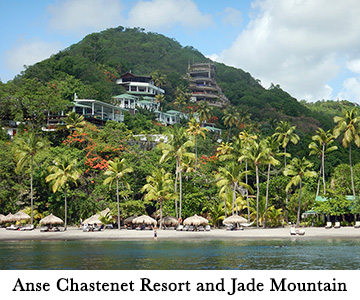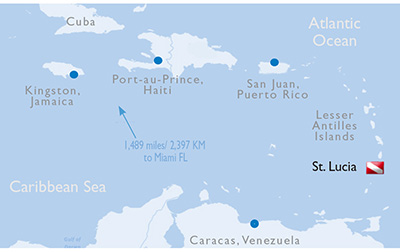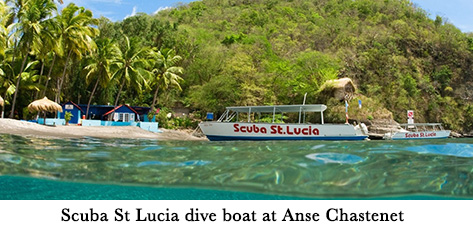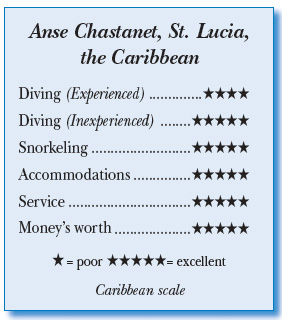Anse Chastanet, St. Lucia, the CaribbeanContents of this Issue: Anse Chastanet, St. Lucia, the Caribbean Neal Watson and Bimini Big Game Club Get Sued Book Review – Muck Diving by Nigel Marsh Bora Bora and Tikehau, French Polynesia Poisonous Air — It’s Very Serious When It Happens Shark Movies: the Good, the Bad, and the Ugly Villa Markisa, Tulamben, and Bali, Indonesia Undercurrent Aids Subscriber with Travel Problems Suunto Recalls ALL Computer Transmitters and PODs Online Dive Trip Booking Portals: Part II Tropical Ice, in paperback – “Perhaps the best scuba thriller ever” Editorial Office: Ben Davison Publisher and Editor Undercurrent 3020 Bridgeway, Suite 102 Sausalito, CA 94965 it’s not just for diving from the August, 2017 issue of Undercurrent
It was the last day of diving St. Lucia, and we were on the 165-foot (50m) Lesleen "M" wreck, which sits at about 70 feet. The visibility was 50-70 feet (15-22 m) and my dive light had failed, but with plenty of ambient light inside the wreck, I took a quick pass through the companionway while my buddy followed. Alongside the wreck, a stingray nestled in the grass, and on the top deck were two enormous scorpion fish, a golden-tail moray, and the only hairy clinging crab of the week. After a leisurely 45 minutes, it was time to end the dive. As I headed to the line for my safety stop, the current picked up, and when my three minutes were up, it was ripping! Frantic divers crowded the line leadingup from the wreck to the boat's starboard ladder, so I headed to the port ladder, grabbing it as I flew past. A couple of others missed and drifted past. The quick-thinking crew immediately threw out lifesaving rings. The drifting divers grabbed them as they went past, and the crew pulled them. One divemaster shook his head. "Wow!" he said, as he climbed the ladder, acknowledging the surprise.
The day we arrived, staff from Anse Chastanet greeted our group, then loaded the van for the one-hour-and-20-minute drive, the last 20 minutes going up the two-mile hill from the main road to the resort at a snail's pace on a mostly one-lane, severely pot-holed road, with sheer drop-offs on one side! At the hotel, Charlotte, one of the dive shop managers, gave a general orientation, I handed over my pre-filled forms, sipped a delicious local fruit drink, and headed for my room. Anse Chastanet is set beautifully into the side of a mountain. "Anse" means small bay and "Chastanet" is the last name of the original French owners. Anse Chastanet began as a sugar plantation worked by slaves. The current owners purchased the land and original buildings back in the early 1970s and built 49 rooms served by 250 employees. In 2006, they opened Jade Mountain, with 29 upscale "sanctuaries" higher on the mountain. Today, the combined properties encompass more than 600 acres with 500 employees. The original rooms are pretty basic, with a bed or two, bathroom, storage space, and a screened lanai. They are closest to the breakfast buffet, and as one goes up the hill -- a hundred steps or more -- the rooms get more expensive. If one were to be at the beach and remembered something left behind, one would most likely leave it there rather than climb back up. I traveled with a large group, all Americans, and my buddy and I ended up in an upgraded room, higher up the mountain; our room was designed without one wall to bring in nature, which meant better breezes but also more bugs, and occasional birds, especially if they heard one of the small refrigerators being opened. The beds are shrouded in netting, and the mosquitoes were not too bad, but one person became covered with bites, most likely from sand fleas (no-see-ums) on the beach; anyone sensitive to bugs should slather up. For people who don't care to make the long schlep of the hill to their rooms, there are more expensive beach-level rooms -- the only ones air-conditioned -- with views of the tennis court; all other rooms have views of either the rainforest, the stunning Piton Mountains, the ocean, or possibly all three. It's about 100 steps from the breakfast buffet down to the beach and the dive shop, and amazingly, the only person I saw slip on the stairs was a staff member, who laughed it off. It was also possible to take a shuttle to the back of the beach-level rooms. The first morning I set out my dive bag in front of my room, and staff came by with a pick-up truck to haul it down to the dive shop; they would also haul it back up to the rooms if desired. At the dive shop equipment storage area, I stored my items in a small locker, with a tiny keyed lock, and hung my gear on moveable racks in their spacious storage room, though it could get crowded with a full complement of 50 or more divers. The congestion was eased somewhat when the racks of BCs and wetsuits were rolled out of the storage area and spread out, but some mornings it took a while to find all my gear. Our first dive was from shore to demonstrate our abilities to clear our masks and retrieve our regulators; then we followed the guide along the wall that we would dive at night. They also offered a complimentary led shore dive each afternoon, but no shore diving on your own.
At Piton Wall, I saw two sharp-tail eels, three lobsters, several lionfish, many spotted moray eels, a large puffer fish, and a teenage French angelfish. Most dives were one-way dives, going with the modest current to be picked up by the boat. However, at Jalousie I was uncomfortable with a strong current that wanted to push me out and down. Several sites had mild thermoclines at 60 feet (18m) and again at 80 feet (25m), making the water look wavy below and above. Visibility ranged from 50 to 100 feet (15 to 30m) throughout the week. Some beginner divers were uncomfortable with the current. However, this is a good place to get current practice in preparation for tougher diving. Between morning boat dives -- and fresh fruit or fresh pastries -- we usually returned to the dive shop for fresh tanks; with no head on the boat, it was a welcome break. We spent one surface interval in the nearby town of Soufriere, which was overrun with cruise ship tourists. One day, we had a beach lunch at the next property. One doesn't go to Anse Chastanet just for the diving, though it's above average for the Caribbean. The food and ambience provide the complete picture. Breakfast consisted of various juices -- try the soursop -- fresh yogurts, smoothies, pastries, cereal, and hot cooked menu meals. I gave up on eggs when over-easy arrived over-hard, but the French toast was to die for! Lunches were at beach level, sometimes buffet, ranging from delicious grass-fed beef hamburgers and BBQ fish burgers to local offerings and desserts. Sometimes menu descriptions were not what my mind pictured, and meals could be an unexpected, though pleasant surprises once they arrived. They did go out of their way to accommodate special diets. Afternoon tea was available with a special menu. Upstairs, the Treehouse Restaurant had a "tropical world" cuisine, and items changed nightly; a vegetarian menu was available at either the Treehouse Restaurant or a smaller vegetarian restaurant, and this menu did not change during the week. One of my favorite dinners was vegetable lasagna made with a creamy sauce rather than pasta sauce. Dinners sometimes lasted over two hours, depending on how late one arrived and how many were sitting at the table. Appetizers, salads, a main course, and desserts were offered, although I usually did not partake of everything, and after night dives I only had an appetizer and dessert because it was so late. Some folks enjoyed the downstairs Indian dinner restaurant or simple meals at the beach grill.
One morning I awoke at 5:30 a.m. and walked down to the beach. A leaky boat with four locals pulled into shallow water, then threw out a net. A guest swimming yelled "Why here?" and a local replied, "This is my country." They left within 25 minutes. A staff member later told me that the area is an approved fishing zone, but fishing is not allowed in the marine preserve, such as Fairy Land.
At the weekly manager's rum punch party, local rum and appetizers are served up as a steel drum band entertains; afterwards a huge buffet, with six different salads, pumpkin crab soup, roasted pig, beef, chicken, local vegetable dishes, and desserts like mini fruit tartlets, cheesecake, local chocolate bars, fudge, lemon tarts, and more. In the bacchanalian atmosphere, a few guests danced, pulling in an occasional staff member. Other nights, there was entertainment until 10 or 10:30 p.m. I've been to Anse Chastanet several times. Day dives are mostly pleasant and better than average for the Caribbean, and their night shore dives never disappoint. On one I saw slipper lobsters, a spotted spiny lobster, a red banded lobster, and Caribbean spiny lobsters. In the coral, I saw channel clinging crabs, batwing coral crabs, a pregnant barber pole shrimp -- they're common -- a halfinch- long seahorse hiding in the weeds, a few cleaning stations with Peterson and spotted cleaner shrimps, a viper moray, sponge crab, and many more eels. During the week, I saw one turtle but no sharks or other larger fish. Barrel sponges -- short ones, tall ones, fat ones, skinny ones, wide ones, and narrow ones -- are everywhere, one at least a meter tall. That said, Anse Chastanet is expensive and works better for groups of eight who take a package. Beginning divers can get a safe introduction from competent guides to the Caribbean, to drift diving, and to the basics of undersea life. -- D.Y. Our undercover diver's bio: Having been certified since the early '70s, I've logged about 3800 dives. While I hate the stress of travel, I buck up and love diving around the world. My best dives were in the '90s at Sipadan, when you were still allowed on the island, with showers in the jungle and sinks hanging on trees. I plan on diving until my last breath, even if I have to crawl into the water.
|

I want to get all the stories! Tell me how I can become an Undercurrent Online Member and get online access to all the articles of Undercurrent as well as thousands of first hand reports on dive operations world-wide
| Home | Online Members Area | My Account |
Login
|
Join
|
| Travel Index |
Dive Resort & Liveaboard Reviews
|
Featured Reports
|
Recent
Issues
|
Back Issues
|
|
Dive Gear
Index
|
Health/Safety Index
|
Environment & Misc.
Index
|
Seasonal Planner
|
Blogs
|
Free Articles
|
Book Picks
|
News
|
|
Special Offers
|
RSS
|
FAQ
|
About Us
|
Contact Us
|
Links
|
3020 Bridgeway, Ste 102, Sausalito, Ca 94965
All rights reserved.

 Speaking of the dive guides, we had an exceptional crew, with lots of jokes and laughter, and plenty of competence: Captain Garfield, mate Emmanus, and guides Errol, Dave, and Bradley did a great job, helping divers in and out of the water, pulling in the tanks of those who doffed them in the water, and keeping track of everyone during the dives while ensuring a junior open water diver stayed above 40 feet (12m). Guides led each dive dragging a surface buoy; usually the current was mild, but still were one-way dives. They changed 80 cu. ft. (11 liter) tanks between dives and helped people check Nitrox fills. After each dive, they broke down, rinsed, and hung BCs and regulators.
Speaking of the dive guides, we had an exceptional crew, with lots of jokes and laughter, and plenty of competence: Captain Garfield, mate Emmanus, and guides Errol, Dave, and Bradley did a great job, helping divers in and out of the water, pulling in the tanks of those who doffed them in the water, and keeping track of everyone during the dives while ensuring a junior open water diver stayed above 40 feet (12m). Guides led each dive dragging a surface buoy; usually the current was mild, but still were one-way dives. They changed 80 cu. ft. (11 liter) tanks between dives and helped people check Nitrox fills. After each dive, they broke down, rinsed, and hung BCs and regulators. After donning my 5mm wetsuit for the 82°F (28°C) water (I get cold easily), I waded out to the 46-foot (14m) Newton for my first boat dive, boarded with a helping hand via a lowered bow, and found my assembled BC and regulator. Twenty-four divers, one person short of the maximum capacity, crowded my boat for the two morning and two afternoon dives, but since we knew each other as part of the group traveling together, we managed.
After donning my 5mm wetsuit for the 82°F (28°C) water (I get cold easily), I waded out to the 46-foot (14m) Newton for my first boat dive, boarded with a helping hand via a lowered bow, and found my assembled BC and regulator. Twenty-four divers, one person short of the maximum capacity, crowded my boat for the two morning and two afternoon dives, but since we knew each other as part of the group traveling together, we managed. Luckily, all this eating can be somewhat mitigated by stair climbing, so back down to the beach for more diving. At Fairy Land, Creole wrasse, brown chromis, and sergeant majors formed sizeable schools; I saw around 30 squid and three tarpon off in the distance, as well as eels, tiny trunkfish, spider crabs, lobsters, and several molted empty lobster bodies. What a spectacular dive this would have been with better than 40 to 50-foot visibility; visibility during the week ranged anywhere from 40 to 100 feet (12 - 30m). Unfortunately, I also saw an illegal fish trap and a line that probably led to another, deeper one, which I reported to the dive manager.
Luckily, all this eating can be somewhat mitigated by stair climbing, so back down to the beach for more diving. At Fairy Land, Creole wrasse, brown chromis, and sergeant majors formed sizeable schools; I saw around 30 squid and three tarpon off in the distance, as well as eels, tiny trunkfish, spider crabs, lobsters, and several molted empty lobster bodies. What a spectacular dive this would have been with better than 40 to 50-foot visibility; visibility during the week ranged anywhere from 40 to 100 feet (12 - 30m). Unfortunately, I also saw an illegal fish trap and a line that probably led to another, deeper one, which I reported to the dive manager. For a nondiver, the Anse Chastanet is a perfect
venue, supplemented with activities ranging
from chocolate and wine pairings (Anse Chastanet
produces its own chocolate) to mountain biking,
hiking up Gran Piton mountain, or indulging in a
hot springs mud bath, largely morning activities.
Complimentary yoga is offered twice a day. During
a complimentary afternoon plantation tour, lasting
about two hours, guide Meno describes the history
of Anse Chastanet and introduces guests to the
local fruits and trees.
For a nondiver, the Anse Chastanet is a perfect
venue, supplemented with activities ranging
from chocolate and wine pairings (Anse Chastanet
produces its own chocolate) to mountain biking,
hiking up Gran Piton mountain, or indulging in a
hot springs mud bath, largely morning activities.
Complimentary yoga is offered twice a day. During
a complimentary afternoon plantation tour, lasting
about two hours, guide Meno describes the history
of Anse Chastanet and introduces guests to the
local fruits and trees. Diver's Compass: Non-stop flights run from New York, Charlotte,
Miami, Atlanta and London ... My $2299/person package ($1999 for
non-divers) included a superior room with 12 boat dives, two night
shore dives, extra scheduled beach diving, breakfast, lunch, afternoon
tea and dinner, all taxes, service fees, and tips, airport
transfers, welcome cocktail, manager's rum punch party, mini-sailing,
windsurfing, use of tennis court and tennis equipment, use of
beach chairs and beach towels, guided tour of the plantation, free
nitrox, and complimentary non-alcoholic beverages. An unlimited
alcoholic beverage package ran $252 for the week ... they offer a lionfish wine
paring tasting for $45.
Diver's Compass: Non-stop flights run from New York, Charlotte,
Miami, Atlanta and London ... My $2299/person package ($1999 for
non-divers) included a superior room with 12 boat dives, two night
shore dives, extra scheduled beach diving, breakfast, lunch, afternoon
tea and dinner, all taxes, service fees, and tips, airport
transfers, welcome cocktail, manager's rum punch party, mini-sailing,
windsurfing, use of tennis court and tennis equipment, use of
beach chairs and beach towels, guided tour of the plantation, free
nitrox, and complimentary non-alcoholic beverages. An unlimited
alcoholic beverage package ran $252 for the week ... they offer a lionfish wine
paring tasting for $45.